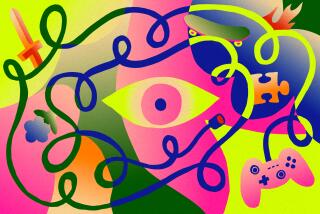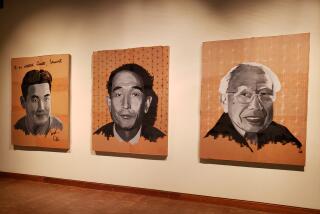‘Takeshi and Hiroshi’ on Apple Arcade is a delightful exploration of familial bonds
- Share via
When we talk about superhero, sci-fi or fantasy films as frivolous or worse, when we write them off as something only for children, we not only forget their mythic and metaphorical properties, but we mistake their audiences as embodying the superficial traits they attribute to those movies.
“Takeshi and Hiroshi” could be similarly underestimated. It’s a short, relatively easy and deceptively simple mobile game available for the Apple Arcade subscription service from Japanese developer Oink Games that explores our relationship to art that’s seemingly aimed at the youth. A rare and delightful work, it’s essentially a game within a game — or, more accurately, a short animated film with puppet-like animation inter-spliced with some sword-and-sorcery moments. Here, heroism is equally about slaying monsters and opening ourselves up to bond with others. If not the flashiest Apple Arcade game, it’s perfect for a mobile subscription service: It’s approachable, it’s easy to finish in a day and it emphasizes games as a narrative medium.
Throughout, there are dragons, skeletal-like warriors and and powerfully damaging fireballs, but this is all a side story — a diversion from what really matters. In “Takeshi and Hiroshi,” that’s two brothers. The younger one, Hiroshi, has re-occurring medical problems that land him in the hospital. The older one, Takeshi, is a budding game designer who means well but regularly shuts himself off from his teenaged peers who care about him. Life lessons are handled with optimism, silliness and charming art touches. Among my favorite: a box of fried pastries from a shop called “Donuts & Dragons.”
Often, “Takeshi and Hiroshi” is a celebration of play. Takeshi is in the midst of designing a fantasy game called “Mighty Warrior.” Takeshi’s game is overly simplistic and a little broken. It doesn’t really work unless Takeshi’s running it remotely from his own computer, adding fixes and patches in real time to keep the young Hiroshi entertained.
This is where “Takeshi and Hiroshi” shifts to what is essentially its “game-mode.” As Hiroshi plays the chapters his brother builds for him, we select which monsters he’ll encounter. The goal is to create a challenge for Hiroshi but not frustrate him. There’s some not entirely subtle messaging here too as Hiroshi’s illness has made him too insecure to go to school. But as he advances through his brother’s game, he does so by managing his “stress” and “joy” levels, ultimately making the point that maximizing the latter comes from feeling unafraid to confront and control the former.
Keita Takahashi, known for ‘Katamari Damacy,’ took six years to make his new game ‘Wattam.’ How child’s play and diverse Vancouver inspired him.
From a purely mechanical standpoint, “Takeshi and Hiroshi” requires some casual strategic planning in finding a mix of opponents that will result in Hiroshi’s warrior nearly being overwhelmed. But as Takeshi is trying to boost Hiroshi’s confidence in showing him that life is richer when one doesn’t run from the apparently insurmountable, Takeshi himself is failing at the very lessons of his game. The seven chapters of “Takeshi and Hiroshi,” which shouldn’t take one more than 60 to 90 minutes to complete, are a combination of these simple battles and delightful animated sequences featuring Takeshi and his pals.
While Hiroshi is learning how to better conquer life via his attachment to his brother’s game, Takeshi is at risk of disappearing into his work. When a classmate, Erika, with an apparent crush on him tries to get closer and offer advice, he gives into his own fears of abandonment and shoves her away. But “Takeshi and Hiroshi” balances this with humor, as moments later we see that Takeshi’s monsters are modeled after those he knows.
Some of this is resolved a little too quickly and neatly. We never, for instance, see how Erika responds to having a gargoyle named and modeled after her, a moment that would have been nice to have in-game as we could see Takeshi finally be honest with her and his feelings. Tonally, “Takeshi and Hiroshi” leaves any more difficult moments for the audience to imagine.
And yet, as the story unfolds we begin to witness how the brothers are teaching something to the other. Yes, they’re bonding over a game, but the game in “Takeshi and Hiroshi” is instead saying what so many of us — young, middle-aged and old alike — struggle to understand: If we turn our backs when facing the unknown, the difficult or that which makes us vulnerable, we’ll miss out on life’s biggest rewards. And sometimes we can learn all that from a talking dragon.
"Takeshi and Hiroshi"
More to Read
The biggest entertainment stories
Get our big stories about Hollywood, film, television, music, arts, culture and more right in your inbox as soon as they publish.
You may occasionally receive promotional content from the Los Angeles Times.











